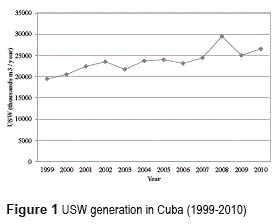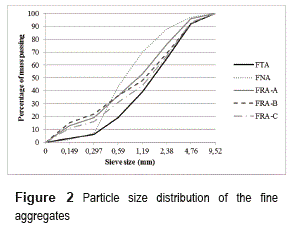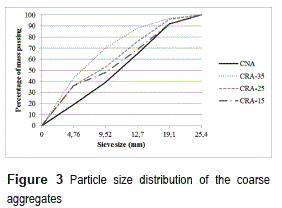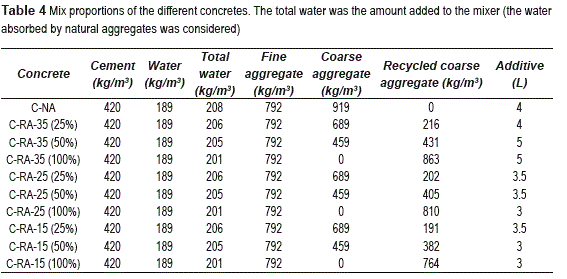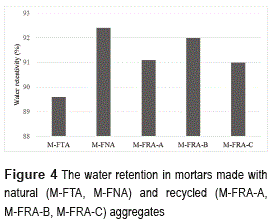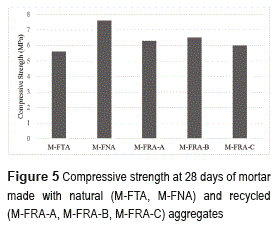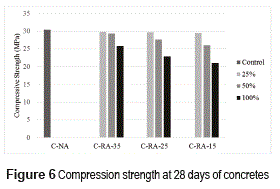Services on Demand
Journal
Article
Indicators
-
 Cited by SciELO
Cited by SciELO -
 Access statistics
Access statistics
Related links
-
 Cited by Google
Cited by Google -
 Similars in
SciELO
Similars in
SciELO -
 Similars in Google
Similars in Google
Share
Revista Facultad de Ingeniería Universidad de Antioquia
Print version ISSN 0120-6230
Rev.fac.ing.univ. Antioquia no.71 Medellín Apr./June 2014
ARTÍCULO ORIGINAL
The production of construction and demolition waste material and the use of recycled aggregates in Havana, Cuba
La producción de residuos de construcción y demolición y el uso de agregados reciclados en la Habana, Cuba
Elier Pavón1*, Iván Martínez2, Miren Etxeberria3
1Department of Civil and Environmental Engineering, University of Brasilia (UnB). Darcy Ribeiro Campus, SG-12. CP 70910-900. Brasília, Brasil.
22Deparment of Civil Engineering, Instituto Superior Politécnico José Antonio Echeverría (Cujae). Street 114, # 11901, e/ Ciclovía y Rotonda, Marianao. CP 19390. La Habana, Cuba.
3Department of Construction Engineering, Faculty of Civil Engineering, Universitat Politécnica de Catalunya. Jordi Girona 1-3, Edifici C1. CP 08034. Barcelona, Spain.
*Autor de correspondencia: teléfono: + 55 + 61 + 3107 3300, fax: + 55 + 61 + 3107 5540, correo electrónico: elierpavon@gmail.com (E. Pavón)
(Recibido el 14 de junio de 2013. Aceptado el 04 de marzo de 2014)
Abstract
This paper deals with the analysis of the generation of Construction and Demolition Waste (CDW) in Havana, Cuba, for the period 1999 to 2010 and its possible use in the manufacturing of recycled aggregates in mortar and concrete production. In order to define the possible applications of the CDW as aggregates in mortar and concrete production the characteristics of the waste as well as studying the existing technologies available in the province for their treatment were analysed. Based on the experimental results, it was determined that the recycled fine aggregates of a mixed composition achieved the minimum requirements defined by Cuban regulations. All the mortars produced with recycled fine aggregates achieved a compressive strength of 5.2 MPa after 28 days which is the minimum requirement for a Type III mortar, consequently they could be used in the manufacturing of masonry mortar. The recycled coarse aggregate originating from pre-cast floor elements could possibly be used in the production of structural concrete for medium and low aggressive environments when concretes were made with 50% and 100% of recycled coarse aggregates in substitution of the natural aggregates. respectively.
Keywords:Urban solid waste (USW), construction and demolition waste (CDW), recycled aggregates, mortar, concrete, Havana, Cuba
Resumen
En este trabajo se realiza un análisis de la generación de Residuos de Construcción y Demolición (RCD) para el período de 1999 a 2010 en La Habana, Cuba y se define su posible uso en la fabricación de áridos reciclados para la producción de mortero y hormigón. Para la definición de las posibles aplicaciones de los RCD como agregados en la producción de mortero y hormigón, se analizaron las características de los residuos, así como el estudio de las tecnologías disponibles actualmente en la provincia para su tratamiento. Basado en los resultados experimentales, se determinó que los áridos finos reciclados de composición mixta cumplían con los mínimos requisitos exigido por las normas cubanas. Todos los morteros producidos con áridos reciclados finos obtuvieron una resistencia a compresión de 5.2 MPa a los 28 días, que es el mínimo establecido para morteros tipo III, por lo que pueden ser utilizados en la producción de morteros de albañilería. El árido grueso reciclado originado de elementos de hormigón prefabricado puede ser utilizado en la producción de hormigón estructural para ambientes de baja y media agresividad, con sustituciones de 50% y 100%, respectivamente, de árido natural por reciclado.
Palabras clave:Residuos sólidos urbanos (RSU), residuos de construcción y demolición (RCD), agregados reciclados, mortero, hormigón, Habana, Cuba
Introduction
The generation of Construction and Demolition Waste (CDW) is a topic of great interest to the vast majority of city authorities throughout the world. As a result of this interest there has been significant research carried out in many countries focusing on the quantifying of the waste and on the proposals of new alternatives for dealing with it. In the period from 2000 to 2010, 87 articles were published by eight of the most important journals that address these issues on an international level [1].
The quantification of the CDW began to gain force in the 80's with works such as that of Poon et al. [2], which shows data dating from the year 1986 onwards, when they first started to record the percentages of waste that were deposited in landfills and public areas as well as evaluating alternatives for their classification and treatment.
Most of the data concerning CDW generation can be found in posterior publications dating from the year 2000. These publications show the values from the 1990s to the early 2000s, the amount of urban solid waste (USW) and CDW usually being determined in millions of tons. CDW represents between 14-44% of the USW weight generated, values obtained from various articles [3-5]. In addition, one of the most recent publications analyses the methodologies dedicated for the estimation of the volume of CDW that new buildings are capable of generating [6]. These estimations are carried out at the design stage of the building by using computerized dynamic models to evaluate the types of recycling altematives through the comparison of economic and environmental policies [7].
The generation of CDW is not documented in La Habana, consequently this study shows estimated data which has been collected from companies and organizations in the city, which are responsible for the collection and treatment of the waste of all USW. The latest known data concerning the generation of Cuban Urban Solid Waste (USW) corresponds to the period 1999-2010. Figure 1 shows these values, obtained from the National Office of Statistics and Information (ONEI). In the same data it can be seen that the generation of USW has increased over the past 10 years at a rate of 2.2% per year, which signifies a difference in 2010 with respect to 1999 of over 5,000,000 m3. It is important to note that in 2008 there is a peak in the behaviour shown, this was due to the effect of two hurricanes (Gustav and Ike). The waste collected in the country in the period 2004-2010 on average, reached 370 kg/ person/year (using the data of number of persons per province and total USW weight provided for the ONEI [8]), while countries in the European Union generated 480 kg/person/year [9].
Havana generates around 37% of Cuba's total waste, nearly 2/5 parts of all waste generated. This value is calculated from the data of USW generation in the country, published between 1999-2010 by the ONEI [10].
Cuba's capital, Havana, has an approximate area of 721 km2 and 2.2 million inhabitants, which represents less than 1% of the surface area of the country and 19% of Cuba's total population. Havana is divided into 15 Municipalities. It was found (according to the data provided by the municipal enterprises of the community services) that the highest rates of production of waste were from northwest, from the municipalities of Diez de Octubre, Habana del Este, Plaza and Playa, which constitute four of the five most populated municipalities of the city. Habana Vieja (Old Havana) is the highest producer, but it has a different policy on the use of CDW waste to the other municipalities. It has not been taken into account in this research work.
The estimated volume of CDW generated for municipalities during period 2004-2010 was determined according to the data provided by the provincial and municipal hygiene and solid waste collection enterprises. The volume of CDW generated in Havana was estimated to have exceeded 420,000 m3 per year [11], which is approximately the equivalent of 1,100 m3/day. On the other hand, in other studies carried out the values obtained were of 1,170 m3/day by Soto [12], 1,050 m3/day in a study by The Ministry of Construction [13], and an estimation of1,174 m3/ day in a study by Manchón [14]. The production of CDW in Havana during the last 5 years studied was as average a 5% (ranging from 3.8% to 7%) of the total value of the USW produced, among the different municipalities. These values are low in comparison with some of the data found internationally in countries such as Hong Kong, Germany and Finland, which show figures of 38%, 19% and 14 % in weight, respectively [15]. In countries belonging to the American continent such as the U.S. and Brazil, the values are around 29% and 15%, respectively [5]. Data below 10% can only be found in Thailand (7.7%) for the period 2002-2005 [4].
The CDW used in the production of recycled aggregates are classified according to their compositions, basically in three groups (concrete, ceramics and mixed), and are crushed in mobile plants at the demolition site (on site) or transported to large fixed plants (off site). Recycled aggregates, depending on their composition and physical-mechanical properties, can be used in partial or total substitution of natural aggregates in the manufacturing of mortars and concretes. In accordance with the use of recycled fine aggregates, the aggregates which are of a mixed composition are generally used in the production of masonry mortar.
The majority of the volume of CDW waste generated in Havana is produced from three sources: (1) Total and partial demolition of buildings and houses, (2) Excess building materials from new construction and renovation works on small houses or urbanizations; (3) Waste from building products made by pre-casting concrete companies. (This classification was defined in a research project led by the authors, entitled: ''Manejo de residuos de construcción y demolición, de la comunidad cubana'', supported by the Spanish International Cooperation Agency for Development (AECID)).
The obtained waste materials are not in the same conditions in any of the three different sources of the CDW's origin. The waste obtained from demolitions (1) is collected in containers and stored on sidewalks and streets near the demolition site. The accumulation of waste is easily accessible to the public, so depending on its location and storage time it may become contaminated. Meanwhile, the waste material generated by construction companies (2), due to its limitation of access to the public, it would only be mixed with residues from its own construction process. In the case ofthe waste material produced from the pre-cast concrete manufacturers and industries (3), these are usually not contaminated and can be used under the conditions found.
It is difficult to accurately determine the volume (in percentage) representing each of these sources, but it is estimated that the first two ((1) and (2)) generate more than 90% of the CDW material, according to the data provided by the municipal enterprises of the community services (Empresas Municipales de Servicios Comunales) and the provincial hygiene unit (Unidad Provincial Presupuestada de Higiene) in the period 2004 - 2010. The waste obtained from source (3) is industrial waste from the production of building materials, primarily from pre-cast concrete products such as panels, slabs, blocks and tiles. There is also, to a lesser extent, ceramic waste which is generated from the production of bricks, tiles and sanitary fittings.
The properties of mortar manufactured with recycled aggregates vary according to the composition and the fineness (number of particles <75 microns) of the recycled aggregates. Due to the high porosity of the recycled aggregate and its direct impact on the effective water-cement (w/c) ratio [16], both physical and mechanical properties gave inferior results to mortar made with natural aggregate. However, mortars made with recycled aggregates with finer grading size, showed greater adherence to brick [17,18]. Accordin to investigations conducted by Vegas et al. [19], the substitution of 25% of natural aggregates by recycled fine aggregate obtained from concrete waste, produces a mortar with similar properties to conventional mortar. However, in mortars made with 50% and 100% recycled fine aggregate, the compression strength may suffer a loss of 15% and 30%, respectively [20]. Moreover, using mortars which substituted natural aggregates by 50% of recycled fine aggregate from ceramic waste showed better or similar physical and mechanical properties to those of conventional mortar [21]. In some cases, mortars manufactured with 100% substitution of natural aggregates for mixed recycled aggregates, mainly composed of ceramic material, improved the bond, compressive and flexural strength properties obtained by the natural aggregates mortars [22].
Recycled coarse aggregates have been extensively studied, specifically the use of recycled concrete aggregate for structural concrete production [23-29]. It is known that up to 20% of recycled concrete aggregate can be used in the substitution of natural aggregate in structural concrete, obtaining similar mechanical properties to those of the conventional concrete, as also does durability [30]. The concrete produced with 25% and 50% of recycled concrete aggregate achieved similar mechanical properties to those of conventional concrete [24]. The application of these recycled aggregates has even reached the field of high performance concretes [31-32].
In this research work, samples of the recycled fine aggregates produced on-site, which were obtained from all of the three sources, were crushed and then tested in order to evaluate their physical properties. The production of recycled coarse aggregate was only carried out in the laboratory and its properties were also analysed. The obtained results were then compared with the minimum requirements stipulated by Cuban regulations and in its ASTM equivalent, as well as the results obtained from the natural aggregates, mainly used in the city, which had undergone the same testing in order to evaluate their applicability in production of cementations materials, mortar and concrete.
Materials
Raw and recycled fine aggregates
The waste material resulting from origins (1) and (2) are processed locally (on-site) with the use of several small mobile hammer machines which were obtained by various international funding through AECID (Spanish International Cooperation Agency for Development). Three major groups of buildings exist in Havana which produced three types of wastes: A) Housing with ceramic tiled roof and compacted earth and limestone walls. The waste obtained is mainly ceramic and silica; B) Housing with roof formed of steel beams and concrete slabs and walls of ceramic brick; C) Housing with roof formed of reinforced concrete and walls of concrete blocks. The residues are manually introduced into the shredder which, at the same time, permits the classification of the waste materials and removal all impurities. Each one of these machines is capable of producing a daily average of 4 m3 of fine mixed recycled aggregate to use in the manufacture of mortar.
The recycled aggregates were identified as FRA-A, FRA-B and FRA-C, corresponding to each of the three types of the existing buildings. in accordance with its source of origin ((A), (B) and (C)).
Figure 2 shows the particle size distribution of the fine aggregates used. The recycled fine aggregate had a higher content of finer material compared with that of the crushed natural aggregate, which make it favourable for its use in masonry mortar. However, none of the aggregates, both natural and recycled, complied with the requirements of the NC 657:2008 [33] and ASTM C144 [34] standards, which determine the fineness of the fine aggregate for use in mortars. This deficiency led to the use of a high content of filler in the production of mortars in order to create an adequate mixture of both fine and larger particles.
Table 1 shows the main physical properties of the natural and recycled fine aggregates that were tested.
The specific gravity values of recycled fine aggregates were lower than those obtained from the natural aggregate, however, in all three cases the recycled fine aggregates were superior to 1.6 kg/dm3 for mixed aggregates with a larger presence of ceramic and concrete. (taken as a reference from the literature, Working Group 2/5 Concrete recycling, 2006 [35]).
The major differences between the properties of recycled fine aggregates respect to those of natural aggregates were the water absorption capacity and the amount of fine material that passed through the 0.074 mm sieve. The last one being limited in accordance with the ASTM C144 [34] to 10% for the use of aggregates in mortars, although Cuban regulations allow up to 15% depending on the clay content. None of the three recycled aggregates exceeded the last value and, moreover, the high values of water absorption could have a significant impact on the fresh state of the mortar [35].
Raw and recycled coarse aggregate
The CDW produced from source (3), from pre- cast concrete waste, is estimated to be in the order of 1,800 m3 per month [36]. According to Cuban publications, recycled coarse aggregates have only been studied on a laboratory scale. CDW was collected from different pre-cast concrete manufacturers producing pre-cast concrete elements, and it was discovered that the waste material resulting from the concrete production could be classified into three groups depending of the compressive strength of the original concrete, those over 35 MPa, between 30 and 20 MPa and with less than 15 MPa. These concrete waste materials were crushed in a small jaw machine in the laboratory and sieved through a 5 mm sieve, thus obtaining recycled coarse aggregates which were denominated CRA-35, CRA-25 and CRA-15 depending on the source of the concrete residue.
The grading size distribution of the three recycled aggregates and the crushed aggregates (CNA) coming from the Alacranes quarry (the most widely used coarse aggregate in the production of concrete in Havana) was determined (Figure 3). The particle size of the recycled coarse aggregates was similar to the natural crushed limestone. The particle size of the recycled aggregates corresponded to the lower limit of the fraction 5/20 mm, established by the regulation NC 251:2005 [37] for the use of aggregates in concrete.
The recycled coarse aggregates properties varied according to the concrete origin (see table 2), in all three cases the value of the density was above 2.1 kg/dm3 and the absorption values did not exceed 8%.
All the aggregates had less that 1% of material finer than 0.074 mm, on passing through the #200 (0.074mm) sieve set by the Cuban legislation for its use in concrete. As table 2 shows, the recycled coarse aggregates obtained a worse shape type when they were produced from original concrete with higher strength.
In general, the properties of the recycled coarse aggregates had major differences in density and water absorption when compared to those of natural aggregates [35]. The values obtained were in the vicinity of the values found in the literature [38-39] and comply with the provisions of the Cuban regulations for natural aggregates, therefore, based on their properties, they could be used as aggregate for concrete manufacture.
Mortar and Concrete manufacture
Mortar and Concrete manufacture
The recycled fine aggregates produced in Havana due to their mixed composition and adequate high content of fine material (finer than 0.074 mm) could be used in making masonry mortars.
With respect to the recycled coarse aggregate obtained on a laboratory scale, as stated in the previous section these aggregates could be used in the manufactured of concrete as they not only comply with international standard but also Cuban regulations on natural aggregates.
Mortars with recycled fine aggregates
Cuban legislation classifies masonry mortars into 5 types. This classification is associated with the mortar's application. The mortar's compressive strength determines the type of mortar and its properties such as water retention or adhesion, which together with the strength defines its use as a bonding mortar for brick or block laying or as a render.
One of the most used dosages in the making of masonry mortars is the ratio by volume: 1:4:2 (cement: sand: filler), which is required to achieve the properties established by the Cuban regulation NC 791:2010 [40] for a mortar type III. This mortar can be used on exterior or interior load bearing and non-load bearing walls above ground level. Consequently, this mortar covers most of the applications of the mortars used in Havana. This volumetric dosage was used for the manufacture of mortars produced with the natural aggregates. For the production of the recycled aggregates mortars a 1:5:1 volumetric dosage was used. This was due to the higher amount of fine material contained in the recycled aggregate that required a reduction in the use of filler.
Table 3 shows the mix proportion used for the manufacture of each mortar. The mortars were produced using P-350 (35 MPa) cement, limestone filler and recycled and/or natural aggregates, described in the table 1. In all cases the mortars worked with a constant flow of 190±5 mm in the flow table, as described in the Cuban standard NC 170:2002 [41]. In order to achieve that flow, the water-cement ratio of each mortar was varied, non-admixtures was used. The table 3 shows the effective w/c ratio of each mortar, which was determined measuring the free water in the mortar. In order to estimate that value, the absorption capacity of recycled aggregates within 30 minutes was considered. (The 30-minutes absorption capacity was determined following same standard was used to determine 24 hours the Cuban regulation NC 186:2002 [42]; the absorption capacity)
Most of the concrete produced in Havana is ready-mixed concrete and over the past 5 years an average over 65,000 m3/year of this concrete has been produced [43]. Generally two types of ready-mixed concrete are produced, H-30 and H-25, which have compressive strength at 28 days of 30 and 25 MPa, respectively. To evaluate the applicability ofthe recycled coarse aggregates in structural concrete, a control concrete was manufactured using the dosage employed usually in the production of H-30 concrete (P- 350 Cement: 420 kg, Water: 189L, Sand: 792 kg, Gravel: 930 kg, fluidizing additive: 4L). Recycled aggregate concretes were produced with 25%, 50% and 100% of substitution of the natural gravel for the three types of recycled coarse aggregates specified in table 2. Recycled concrete and natural aggregates were used in saturated and dried conditions, respectively. All the concretes were manufactured with a target slump of 120 ± 20 mm. To achieve that purpose, the content of additive were modify in each mix proportion (table 4).
Results and discussion
Mortars with recycled fine aggregates
Figure 4 show the results of the water retention of the mortars produced.
It can be verified that all mortars produced either with natural or recycled fine aggregates, were in excess of the 90% water retention that Cuban regulations require for its use as a bonding mortar for the laying of both concrete blocks or ceramic bricks.
All the mortars obtained a compressive strength of 5.2 MPa after 28 days which is the minimum requirements for a Type III mortar (see figure 5).
As can be seen, the strength of the mortars employing recycled fine aggregates, independent of the type of waste material used, did not vary by more than 15%. In all cases they exceeded the strength of the mortar produced with the natural aggregate FTA. This was a result of the continuity of their particle size and the greater amount of finer particles found in the recycled fine aggregates as well as the low quality of this natural aggregate. In other studies carried out throughout the country using none conventional fine aggregates, the results were similar to those of a mortar produced with recycled mixed aggregate. Employing a 1:6 (cement: aggregate) ratio a compressive strength of 6.7 MPa was obtained at 28 days [44] and mortars made with a ratio of1:5:1 (Cement: Stone Dust: lime) achieved a strength of 6.9 MPa over the same period of time [45]. Mortars using fine mixed recycled aggregates combined with three different fillers were also tested and achieved good performance results [22].
The mortar produced with the recycled fine aggregates obtained from the three predominant types of CDW materials in Havana complied with the requirements stipulated by Cuban regulations for mortars. The defined mortars would cover the major applications currently employed in the use of masonry mortars manufactured with traditional aggregates.
Concrete with recycled aggregates
Figure 6 shows the compressive strength obtained by the control concrete and the nine recycled aggregate concretes at 28 days.
Regarding other outcomes obtained and according to the dosage employed, all recycled coarse aggregates could be used in the manufacture of structural concretes due to the fact that all concretes exceeded the 20 MPa required by the Cuban standard NC 250:2005 [46], for structural concrete. All the concretes produced with 25 and 50% of recycled aggregates (independently of its origin) in substitution of natural aggregate achieved more than 25 MPa of compressive strength, which allows their use in medium aggressive environments, as defined by the above mentioned regulation. In the particular case of concrete produced with 100% recycled coarse aggregate type C-RA-35, this could be used in medium aggressive environments. The concrete made with recycled aggregates C-RA- 25 and C-RA-15 could be used in low aggressive environments [36]. It is important to point out that the properties of these recycled concretes and their scope of use can be improved by the use of mineral additions [47].
Conclusions
The conclusions obtained according to the waste generation, its characteristics and the principle uses of recycled aggregates are:
The construction and demolition waste (CDW) volume exceeds 1,100 m3/day in Havana. Due to the current system of CDW collection employed and the characteristics of Havana's buildings, the composition of demolition waste material is mixed.
The recycled fine aggregate had a higher content of finer material compared with that of the crushed natural aggregate, which make it favourable for its use in masonry mortar.
The mortars made with recycled aggregates achieved the minimum compressive strength required for masonry mortars. The use of recycled fine aggregates improved the compressive strength of the mortars manufactured with the most accessible natural sand in La Havana (FTA).
In the Industries, producing pre-cast building materials there is a volume of waste material which is mainly obtained from concrete and which is easily recyclable as recycled coarse aggregates. These recycled coarse aggregates are adequate for structural concrete production.
Concretes made with 50% of recycled coarse aggregates in substitution ofthe natural aggregates can be used according to their mechanical properties in medium aggressive environments, as defined by Cuban regulations.
Concrete made with 100% of recycled coarse aggregate achieved, according to Cuban regulations, the minimum requirements for its use as a structural concrete for the use in low aggressive environments.
Acknowledgements
The authors would like to thank the Spanish Agency of International Cooperation for Development (AECID) and The Ministry of Foreign Affairs and Cooperation for their financial support which gave rise to the present research work, and would also like to thank the Coordination Improvement of Personnel of a Higher Level (CAPES), by supporting financially.
References
1. H. Yuan, L. Shen. ''Trend of the Research on Construction and Demolition Waste Management.'' Waste Management. Vol. 31. 2011. pp. 670-679. [ Links ]
2. C. Poon, A. Yu, L. Ng. ''On-Site Sorting ofConstruction and Demolition Waste in Hong Kong.'' Resources, Conservation and Recycling. Vol. 32. 2001. pp. 157-172. [ Links ]
3. N. Kartam, N. Al-mutairi, I. Al-ghusain, J. Al-humoud. ''Environmental Management of Construction and Demolition Waste in Kuwait.'' Waste Management. Vol. 24. 2004. pp. 1049-1059. [ Links ]
4. O. Kofoworola, S. Gheewala. ''Estimation of Construction Waste Generation and Management in Thailand.'' Waste Management. Vol. 29. 2009. pp. 731-738. [ Links ]
5. V. Tam. ''On the Effectiveness in Implementing a Waste-Management-Plan Method in Construction.'' Waste Management. Vol. 28. 2008. pp. 1072-1080. [ Links ]
6. J. Solís, M. Marrero, M. Montes, A. Ramírez. ''A Spanish Model for Quantification and Management of Construction Waste.'' Waste Management. Vol. 29. 2009. pp. 2542-2548. [ Links ]
7. W. Zhao, H. Ren, V. Rotter. ''A system Dynamics Model for Evaluating the Alternative of Type in Construction and Demolition Waste recycling center - The case of Chongqing, China.'' Resources, Conservation and Recycling. Vol. 55. 2011. pp. 933-944. [ Links ]
8. ONEI. Tratamiento y Recolección de Desechos Sólidos. 2011. Disponible en: http://www.one.cu/aec2010/esp/02_tabla_cuadro.htm. Accessed: Mayo, 2013. [ Links ]
9. A. Rao, K. Jha, S. Misra. ''Use of Aggregates From Recycled Construction and Demolition Waste in Concrete''. Resources, Conservation and Recycling. Vol. 50. 2007. pp. 71-81. [ Links ]
10. ONEI. Volumen de desechos sólidos recolectados por provincias. 2011. Disponible en: http://www.one.cu/aec2010/esp/02_tabla_cuadro.htm. Accessed: May 5, 2012. [ Links ]
11. I. Muñoz Fernández. Estudio Económico y Ambiental del Cambio de Gestión de Residuos de Construcción y Demolición en la Ciudad de La Habana. Master's thesis. Civil Engineering Department of Construction Engineering. University Polytechnic of Cataluña. Barcelona, España. 2012. pp. 144. [ Links ]
12. I. Soto, O. Soto, E. Pavón, V. Manchón. Estudio de Viabilidad de los Residuos de Construcción y Demolición en Ciudad Habana, Cuba, para Implementar una Alternativa de Gestión de los RCD. 50 Congreso Brasileiro del Concreto. Salvador - Bahía, Brasil. 2008. pp. 21. [ Links ]
13. Pavón E, Etxeberria M, Díaz N. Situación Actual de la Generación de Residuos de Construcción y Demolición en Ciudad Habana y su comparación con índices internacionales. II Convención Internacional de Ingeniería en Cuba. Matanzas, Cuba. 2010. pp. 8. [ Links ]
14. V. Manchón. Estudio de los Morteros de Colocación y Revestimiento Preparados con Arido Fino Procedente del Reciclaje de los Residuos de Construcción y Demolición en la Habana Vieja y Filler Calizo. Master's thesis. Civil Engineering Department, Instituto Superior Politécnico José Antonio Echeverría. Havana, Cuba 2010. pp 117. [ Links ]
15. W. Lu, H. Yuan, ''A Framework for Understanding Waste Management Studies in Construction,'' Waste Management. Vol. 31. 2011. pp. 1252-1260. [ Links ]
16. L. Miranda, S. Selmo. ''CDW Recycled Aggregate Renderings : Part I - Analysis of the Effect of Materials Finer than 75 lm on Mortar Properties.'' Construction andBuildingMaterials. Vol. 20. 2006. pp. 615-624. [ Links ]
17. L. Miranda, S. Selmo. ''CDW Recycled Aggregate Renderings: Part II - Analysis of the effect of materials finer than 75 lm Under Accelerated Aging Performance.'' Construction and Building Materials. Vol. 20. 2006. pp. 625-633. [ Links ]
18. V. Corinaldesi. ''Mechanical Behavior of Masonry Assemblages Manufactured with Recycled-Aggregate Mortars.'' Cement and Concrete Composites. Vol. 31. 2009. pp. 505-510. [ Links ]
19. I. Vegas, I. Azkarate, A. Juarrero, M. Frías. ''Diseño y Prestaciones de Morteros de Albañilería Elaborados con Áridos Reciclados Rrocedentes de Escombro de Hormigón.'' Materiales de Construcción. Vol. 59. 2009. pp. 5-18. [ Links ]
20. J. Khatib. ''Properties of Concrete Incorporating Fine Recycled Aggregate,'' Cement and Concrete Research. Vol. 35. 2005. pp. 763-769. [ Links ]
21. J. Silva, J. de Brito, M. R. Veiga. ''Argamassas com Incorporado de Agregados Cerámicos Avaliafáo do seu Desempenho Face á Água.'' Teoria e Practica na Engenharia Civil. Vol. 11. 2008. pp. 13-21. [ Links ]
22. I. Martínez, M. Etxeberria, E. Pavón, N. Díaz. ''A Comparative Analysis of the Properties of Recycled and Natural Aggregate in Masonry Mortars''. Construction and Building Materials. Vol. 49. 2013. pp. 384-392. [ Links ]
23. F. Debieb, L. Courard, S. Kenai, R. Degeimbre. ''Mechanical and Durability Properties of Concrete Using Contaminated Recycled Aggregates.'' Cement and Concrete Composites. Vol. 32. 2010. pp. 421-426. [ Links ]
24. M. Etxeberria, E. Vázquez, A. Marí, M. Barra. ''Influence of Amount of Recycled Coarse Aggregates and production process on properties of recycled Aggregate Concrete.'' Cement and Concrete Research. Vol. 37. 2007. pp. 735-742. [ Links ]
25. S. Kou, C. Poon, M. Etxeberria. ''Influence of Recycled Aggregates on Long Term Mechanical Properties and Pore Size Distribution of Concrete.'' Cement and Concrete Composites. Vol. 33. 2011. pp. 286-291. [ Links ]
26. M. Martín, M. Zamorano, A. Ruiz, I. Valverde. ''Characterization of Recycled Aggregates Construction and Demolition Waste for Concrete Production Following the Spanish Structural Concrete Code EHE-8. '' Construction and Building Materials. Vol. 25. 2011. pp. 742-748. [ Links ]
27. P. Pereira, L. Evangelista, J. de Brito. ''The Effect of Superplasticisers on the Workability and Compressive Strength of Concrete Made With Fine Recycled Concrete Aggregates.'' Construction and Building Materials. Vol. 28. 2012. pp. 722-729. [ Links ]
28. K. Sagoe, T. Brown, A. Taylor. ''Performance of Concrete Made with Commercially Produced Coarse Recycled Concrete Aggregate.'' Cement and Concrete Research. Vol. 31. 2001. pp. 707-712. [ Links ]
29. V. Corinaldesi. ''Mechanical and Elastic Behaviour of Concretes Made of Recycled-Concrete Coarse Aggregates.'' Construction and Building Materials. Vol. 24. 2010. pp. 1616-1620. [ Links ]
30. S. Levy, P. Helene. ''Durability of Recycled Aggregates Concrete: a Safe Way to Sustainable Development.'' Cement and Concrete Research. Vol. 34. 2004. pp. 1975-1980. [ Links ]
31. A. Ajdukiewicz, A. Kliszczewicz. ''Influence of Recycled Aggregates on Mechanical Properties of HS/HPC.'' Cement and Concrete Composites. Vol. 24. 2002. pp. 269-279. [ Links ]
32. T. Tu, Y. Chen, C. Hwang. ''Properties of HPC with Recycled Aggregates.'' Cement and Concrete Research. Vol. 36. 2006. pp. 943-950. [ Links ]
33. NC 657:2008 Standard. Áridos para Morteros de Albañilería - Especificaciones. Cuban National Bureau of Standards. Havana, Cuba. 2008. pp. 9. [ Links ]
34. ASTM C144 -11 Standard. Standard Test Method for Obtaining and Testing Drilled Cores and Sawed Beams of Concrete. West Conshohocken, Pennsylvania, United States. American Society for Testing and Materials. 2011. pp. 2. [ Links ]
35. Comisión 2, Grupo de Trabajo 2/5 Hormigón Reciclado. Utilización del árido Reciclado para la Fabricación de Hormigón Estructural. Asociación Científico- Técnica de hormigón Estructural - ACHE. Madrid, España. 2006. pp. 166. [ Links ]
36. E. Pavón, M. Etxeberria, N. Díaz. ''Estudio de la Aplicabilidad del Hormigón con Árido Grueso Reciclado en La Habana, Cuba.'' Materiales de Construcción. Vol. 62. 2012. pp. 431-441. [ Links ]
37. NC 251:2005 Standard. áridos para Hormigones Hidráulicos - Requisitos. Cuban National Bureau of Standards. Havana, Cuba. 2005. pp. 16. [ Links ]
38. M. Sánchez, P. Alaejos. ''Study on the influence of attached mortar content on the properties of recycled concrete aggregate.'' Construction and Building Materials. Vol. 23. 2009. pp. 872-877. [ Links ]
39. V. Tam, K. Wang, C. Tam. ''Assessing relationships Among Properties of Demolished Concrete, Recycled Aggregate and Recycled Aggregate Concrete Using Regression Analysis.'' Journal of Hazardous Materials. Vol. 152. 2008. pp. 703-714. [ Links ]
40. NC 791:2010 Standard. Código de Buenas Prácticas Sobre la Preparación, Dosificación, Mezclado y Colocación de los Morteros de Albañilería. Cuban National Bureau of Standards. Havana, Cuba. 2005. pp. 35. [ Links ]
41. NC 170:2002 Standard. Mortero Fresco. Determinación de la Consistencia en la Mesa de Sacudidas. Cuban National Bureau of Standards. Havana, Cuba. 2005. pp. 9. [ Links ]
42. NC 186:2002 Standard. Arena. Peso Específico y Absorción de Agua. Método de Ensayo. Cuban National Bureau of Standards. Havana, Cuba. 2005. pp. 8. [ Links ]
43. A. Reyes. Estudio del Impacto Energético en la Producción de Hormigón Premezclado en la Habana. Graduation thesis. Civil Engineering Department, Polytechnic University José Antonio Echeverría. Havana, Cuba. 2010. pp. 120. [ Links ]
44. J. Alvarez, F. Urrutia, D. Lecusay. ''Morteros de Albañilería con Escombros de Demolición.'' Materiales de Construcción. Vol. 47. 1997. pp. 43-48. [ Links ]
45. J. Alvarez. ''Caracterización de Morteros para Revestimientos con Polvo de Piedra.'' Revista de la Construcción. Vol. 4. 2005. pp. 30-37. [ Links ]
46. NC 250:2005 Standard. Requisitos de Durabilidad para el Diseño y Construcción de Edificaciones y Obras Civiles de Hormigón Estructural. Cuba. Cuban National Bureau of Standards. Havana, Cuba. 2005. pp. 22. [ Links ]
47. E. Pavón, M. Etxeberria, I. Martínez. ''Propiedades del Hormigón de Árido Reciclado Fabricado con Adiciones, Activa e Inerte.'' Revista de la construcción. Vol. 10. 2011. pp. 4-15. [ Links ]













